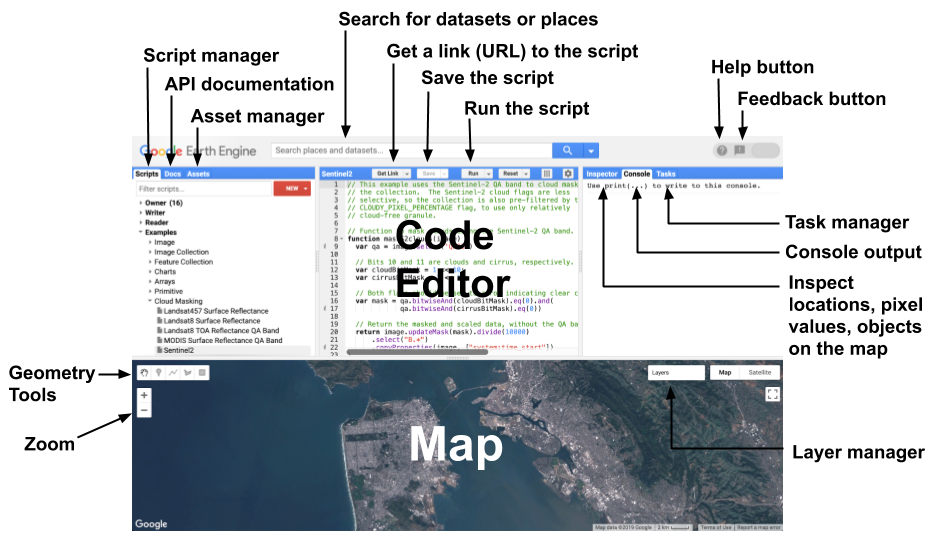11.1 Cloud-based geospatial data processing - Basics¶
In this lesson, we are going to learn the basics of Google Earth Engine (https://earthengine.google.com/).
Get a quick overview¶
- Homepage: https://earthengine.google.com/
- A cloud-based geospatial analysis platform
- Analysis and visualisation tool
- Petabytes of organised available data
- Documentation: https://developers.google.com/earth-engine/
- Code editor: https://code.earthengine.google.com/
Examples¶
- Timelapse
- https://earthengine.google.com/timelapse/
- Global, zoomable videos including 34 years of cloud-free annual mosaics
- Landsat, Sentinel-2A, MODIS, ETOPO11, Hansen Global Forest Change
- Proof that the world is going to hell
Available data¶
- https://developers.google.com/earth-engine/datasets/
- Browse by tags: https://developers.google.com/earth-engine/datasets/tags
- Thematic fields:
- Imagery
- Geophysical
- Climate and Weather
- Surface Temperature: https://developers.google.com/earth-engine/datasets/tags/temperature
- Climate: https://developers.google.com/earth-engine/datasets/tags/climate
- Weather: https://developers.google.com/earth-engine/datasets/tags/weather
- Yes, and more...
Code editor¶
- https://developers.google.com/earth-engine/datasets/
- Web-based IDE
- Based on Javascript
- The heart of the GEE
Javascript¶
A simple script in Python:
int_var = 5
print("int_var is ", int_var)
boolean_var = True;
if boolean_var is True:
print("It is true")
else:
print("It is not true")
list_var = [2, 3, 5, 7, 11]
print(f"second prime number is {list_var[1]}")
dict_var = {"my_key": "my_value"}
print("int_gis " + dict_var["my_key"])
def my_function(arg1, arg2):
return arg1 * arg2
print("2 * 3 is {}".format(my_function(2, 3)))
Its alternative in Javascript:
var int_var = 5;
print("int_var is " + int_var);
var boolean_var = true;
if (boolean_var === true) {
print("It is true")
} else {
print("It is not true")
}
var list_var = [2, 3, 5, 7, 11];
print("second prime number is " + list_var[1]);
var dict_var = {"my_key": "my_value"};
print("int_var is " + dict_var["my_key"]);
// the next works in javascript too
print("myand this returns the same " + dict_var.my_key);
function my_function(arg1, arg2) {
return arg1 * arg2;
}
print("2 * 3 is " + my_function(2, 3));
Javascript and its boolean conditions:
var x;
x = 0;
print(x == true); // false, as expected
print(x == false); // true as expected
x = 1;
print(x == true); // true, as expected
print(x == false); // false as expected
x = 2;
print(x == true); // false, ??
print(x == false); // false
Simple examples¶
Let's get the S2 collection and visualise the data:
var sentinel_col = ee.ImageCollection("COPERNICUS/S2_SR")
// filter by dates
.filterDate('2020-04-01', '2020-06-1')
// filter for the drawn rectangle
.filterBounds(geometry);
// add to the map window
Map.addLayer(sentinel_col, {bands: ['B4', 'B3', 'B2'], man: 0, }, 'sentinel');
Let's get the L8 collection and visualise a cloud-free mosaic. For this example, you will need to draw a geometry object first:
// it does not work with LANDSAT/LC08/C02/T1_TOA
var landsat_col = ee.ImageCollection("LANDSAT/LC08/C02/T1")
// filter by dates
.filterDate('2016-04-01', '2016-06-01')
// filter for the drawn rectangle - DOES NOT WORK FOR ME FOR LANDSAT
.filterBounds(geometry);
// composite to get rid of clouds (the function does not exist for sentinel)
var landsat_col_cloudfree = ee.Algorithms.Landsat.simpleComposite(
{
collection: landsat_col
}
)
// add to the map window
Map.addLayer(landsat_col_cloudfree, {bands: ['B4', 'B3', 'B2'], min: 0, }, 'landsat');
// zoom to the thing
Map.centerObject(geometry, 10);
